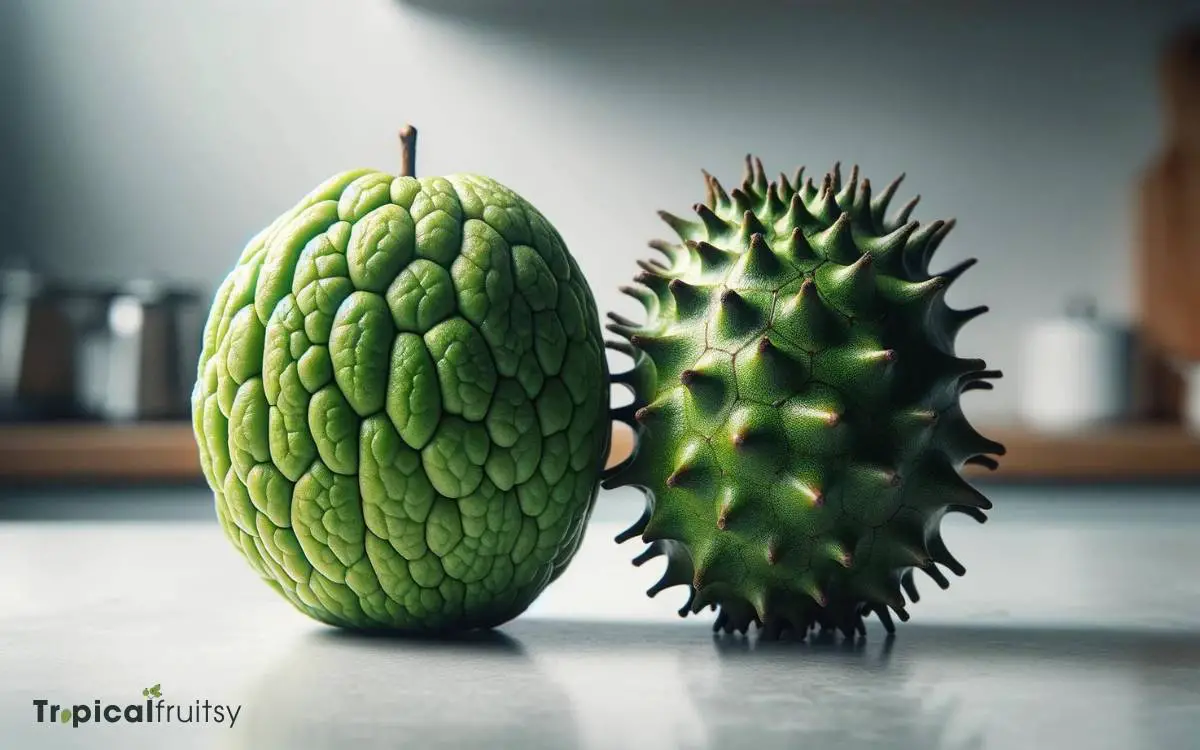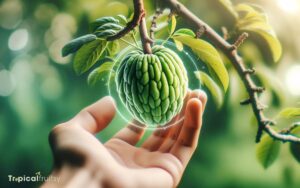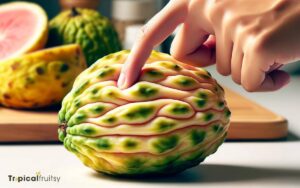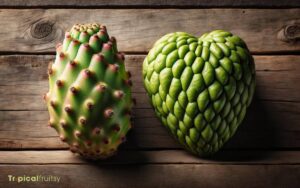Is Cherimoya the Same as Soursop? Discover the Truth!
Cherimoya and soursop are different fruits; both belong to the Annonaceae family but differ in taste, texture, and appearance. Cherimoya has a creamy texture and sweet taste, while soursop is more fibrous with a tangy flavor.
Cherimoya (Annona cherimola) and soursop (Graviola guanabana) are tropical fruits from the same botanical family, yet they possess distinct characteristics:
For example, if you were to cut open both fruits, the cherimoya would reveal a creamy white flesh easily scooped with a spoon, whereas the soursop’s flesh would be segmented and fibrous, often requiring a fork or spoon to separate the flesh from the seeds.
Despite their family ties, cherimoya and soursop offer unique flavors and textures that cater to different palates and culinary uses, highlighting the rich diversity within the Annonaceae family.

Key Takeaway
Understanding Cherimoya Basics
Cherimoya, often hailed as the ‘custard apple,’ is a tropical fruit native to the Andes mountains in South America. It’s recognized scientifically as Annona cherimola.
This fruit is esteemed for its rich, creamy texture and a flavor profile that intriguingly combines notes of banana, pineapple, and papaya.
Cherimoyas thrive in high-altitude, subtropical climates where cool nights and warm days allow for the development of its complex sugars and aromatic compounds.
The fruit’s exterior is green with a unique scale-like skin, and it houses a creamy, white flesh peppered with large, black seeds that aren’t edible.
Researchers focus on the cherimoya’s nutritional benefits, which include a high content of vitamins C and B6, dietary fiber, and antioxidants.
Moving forward, the examination shifts to exploring soursop characteristics, another fruit within the Annonaceae family, yet with distinct qualities.
Exploring Soursop Characteristics
Soursop, known scientifically as Annona muricata, exhibits a complex flavor profile that’s often described as a combination of strawberry, pineapple, and citrus with a creamy texture.
Its nutritional content is rich in vitamins C and B, as well as dietary fiber, which contributes to its reputation as a healthy addition to diets.
In culinary applications, soursop’s distinctive taste and creamy consistency make it a versatile ingredient for beverages, desserts, and savory dishes.
Soursop Flavor Profile
Many describe soursop’s flavor as a complex blend of strawberry and pineapple with underlying notes of citrus and banana.
This multifaceted taste profile is due to the presence of various volatile compounds that interact synergistically.
Soursop’s flavor complexity:
- Predominantly sweet with a slightly sour undertone.
- Texture contributes to the taste experience; the fibrous, juicy pulp affects the perception of flavor. – Varies with ripeness; overripe fruits may have a fermented note.
The scientific community notes that specific esters, lactones, and terpenes in soursop contribute to its distinctive flavor. These compounds are also responsible for the fruit’s aroma, which enhances the overall sensory experience.
Understanding soursop’s flavor profile is essential for culinary applications and for distinguishing it from other tropical fruits like cherimoya.
Soursop Nutritional Content
While exploring the unique taste of soursop, it’s also important to consider its rich nutritional profile, which includes a high content of vitamin C, dietary fiber, and a range of beneficial antioxidants.
Soursop’s composition is notable for its significant vitamin C concentration, a potent antioxidant that serves as a cornerstone for immune defense.
The dietary fiber present in this fruit not only aids in digestive health but also contributes to a feeling of satiety, which can be beneficial for weight management.
Furthermore, soursop contains a variety of antioxidants, such as flavonoids, tannins, and phytosterols, which play a pivotal role in combating oxidative stress within the body, potentially mitigating the risk of chronic diseases.
The scientific community continues to study these constituents for their health-promoting potential.
Soursop Culinary Uses
How does soursop transition from a nutritional powerhouse to a versatile ingredient in the culinary world?
Its unique flavor profile, which combines sweet and tart notes, lends itself to a myriad of culinary applications.
The creamy, slightly fibrous flesh can be utilized in both sweet and savory dishes, providing a tropical nuance.
Culinary Applications:
Beverages:
- Soursop juice, smoothies, and cocktails infuse a refreshing zest, often enhanced with lime or coconut.
Desserts:
- Pulp is incorporated into ice creams, sorbets, and cheesecakes for a rich, exotic taste.
Savory Dishes:
- Its tangy flesh complements seafood and chicken, especially in Caribbean cuisines, where it’s stewed or used in sauces.
The fruit’s properties require careful handling, preserving its nuanced flavors and nutritional benefits while expanding its gastronomic reach.
Botanical Family Ties
Both cherimoya and soursop belong to the Annonaceae family, which encompasses numerous species known for their edible fruit.
This botanical family is characterized by flowering plants that often possess aromatic qualities and bear fleshy fruits.
The family ties between cherimoya (Annona cherimola) and soursop (Annona muricata) are not merely superficial; they share genetic lineage that dictates similarities in their growth patterns, fruit structure, and even their vulnerability to certain pests and diseases.
However, despite these familial connections, they exhibit distinct differences in their respective environments, flavor profiles, and physical appearances.
| Feature | Cherimoya | Soursop |
|---|---|---|
| Scientific Name | Annona cherimola | Annona muricata |
| Origin | Andes of South America | Caribbean, Americas |
| Fruit Texture | Creamy and smooth | Fibrous and grainy |
Comparing Nutritional Profiles
Cherimoya and soursop differ significantly in their vitamin content, with each fruit offering a unique profile that impacts their nutritional value.
A comparison of their caloric content reveals distinct energy contributions, which is essential for understanding their roles in diet and health.
Analyzing these disparities provides insight into the potential health benefits and dietary applications of each fruit.
Vitamin Content Differences
Vitamin content analysis reveals distinct nutritional profiles between cherimoya and soursop, with each fruit offering a unique array of essential nutrients.
While both are rich in vitamins and minerals, their concentrations vary, emphasizing the importance of diversifying fruit intake to obtain a broad spectrum of nutrients.
Cherimoya:
- High in vitamin C; a strong antioxidant.
- Contains vitamins B6 and B1 (thiamine); crucial for brain health and energy metabolism.
- Good source of riboflavin and niacin; aids in growth and digestion.
Soursop:
- Exceptionally rich in vitamin C; even more so than cherimoya.
- Provides a modest amount of thiamine and riboflavin.
- Contains niacin; supports nervous system function.
These differences underscore the complementary nutritional benefits that can be harnessed when incorporating both fruits into one’s diet.
Caloric Value Comparison
Analyzing the caloric value of cherimoya and soursop reveals that cherimoya contains slightly more calories per serving, illustrating the need to consider energy intake when choosing between these fruits.
Specifically, a 100-gram serving of cherimoya yields approximately 75 calories, whereas the same quantity of soursop has about 66 calories.
This discrepancy in energy content may be attributable to the higher carbohydrate concentration found in cherimoya.
Both fruits contribute to one’s daily caloric intake, but the marginally higher caloric density in cherimoya could be a deciding factor for individuals monitoring their calorie consumption meticulously.
It’s essential to integrate this information into dietary planning, especially for those seeking to balance their energy requirements with nutritional benefits.
Distinguishing Flavors and Textures
One key difference between cherimoya and soursop is their distinct flavor profiles and textures, which are easily discernible upon tasting.
Cherimoya:
- Flavor: Often described as a blend of banana, pineapple, and strawberry.
- Subtly sweet with a hint of tartness.
- Texture: Creamy and custard-like, similar to a ripe pear.
- Consistency contributes to its nickname ‘custard apple.’
Soursop:
- Flavor: A complex mix of sweet and sour tones.
- Citrus notes prevail, reminiscent of a lemon or lime.
- Texture: Fibrous and less smooth than cherimoya.
- Contains more juice, which can affect the mouthfeel.
These differences aren’t just perceptible; they’re significant indicators used by botanists and culinary experts to classify and differentiate between the two fruits.
Culinary Uses and Recipes
Exploring the culinary uses and recipes of cherimoya and soursop reveals their versatility in dishes ranging from sweet desserts to savory sauces.
Cherimoya’s creamy texture and sweet flavor lend it to be used in mousse, smoothies, and ice creams, while soursop’s slightly acidic tang is suitable for marinades, sorbets, and cocktails.
| Cherimoya Recipes | Soursop Recipes |
|---|---|
| Cherimoya Custard | Soursop Tea |
| Tropical Fruit Salad | Soursop Sorbet |
| Cherimoya Smoothie | Graviola Sauce for Seafood |
| Baked Cherimoya with Lime | Soursop Cocktail |
| Cherimoya Ice Cream | Soursop Chutney |
The scientific approach to utilizing these fruits involves understanding their flavor profiles and how they interact with other ingredients.
It’s crucial for those seeking to innovate in the kitchen to consider the chemical constituents of cherimoya and soursop, ensuring that recipes highlight their unique tastes without overshadowing complementary flavors.
Health Benefits and Myths
Investigating the health benefits and myths surrounding cherimoya and soursop reveals a complex array of nutritional advantages and unfounded claims.
These fruits boast high vitamin C content, dietary fiber, and antioxidants that contribute to overall health.
Nutritional Advantages:
- Vitamin C: Supports immune function and skin health.
- Dietary Fiber: Aids in digestion and helps maintain a healthy weight.
- Antioxidants: Combat oxidative stress and may reduce the risk of chronic diseases.
Conversely, myths about their ability to cure cancer lack rigorous scientific backing, though some preliminary studies suggest potential anti-cancer properties.
It’s crucial to approach such claims analytically, recognizing the distinction between anecdotal evidence and substantiated scientific research.
This distinction ensures that the public’s understanding is rooted in verifiable data, rather than speculative or overhyped assertions.
Purchasing and Storage Tips
When buying cherimoya or soursop, it’s essential to choose fruits that are firm and free from blemishes or soft spots for optimal freshness and flavor. Upon selection, the maturation process should be monitored.
Both fruits continue to ripen post-harvest, thus careful observation is required to prevent overripening, which leads to a decline in textural quality and potential spoilage.
For storage, cherimoya and soursop should be kept at room temperature until they reach the desired ripeness. To extend their shelf life once ripe, they can be stored in the refrigerator for a few days.
However, it’s critical to note that cold storage may alter the fruit’s texture and taste profile, potentially reducing the sensory pleasure derived from their consumption.
Conclusion
In summary, cherimoya and soursop share botanical kinship yet parade distinct personalities on the palate and nutritional landscapes.
Each fruit boasts unique culinary versatility and a cornucopia of health-giving narratives, despite the occasional exaggerated tale.
Connoisseurs can extend their enjoyment through judicious selection and optimal conservation methods.
Ultimately, these tropical treasures offer a symphony of flavors and benefits, subtly different but harmoniously related within the rich tapestry of nature’s bounty.






